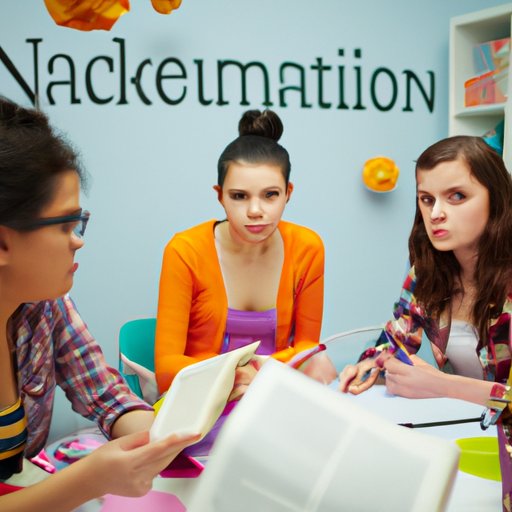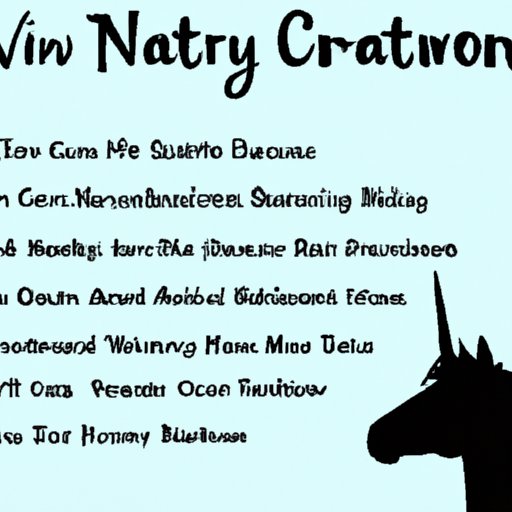Introduction
Creative nonfiction is a type of writing that combines facts with literary elements such as characterization, plot and setting. It is often used to tell true stories in a more engaging way than traditional nonfiction. In this article, we will explore what creative nonfiction is, provide examples of popular works, give a guide to writing it, examine the benefits and challenges of writing it and interview an experienced creative nonfiction writer.

Exploring the Definition of Creative Nonfiction
The term “creative nonfiction” was first coined by American writer Lee Gutkind in the late 1990s. He defined it as “true stories, well-told.” This definition has since been refined over the years, but the basic idea remains the same: creative nonfiction combines facts with literary elements to create compelling stories.
What is Creative Nonfiction?
Creative nonfiction has been described as “the art of veracity” because it blends factual accuracy with vivid storytelling. It is a type of writing that is based on real events or experiences, but uses techniques from fiction to bring those events to life. As Gutkind explains, “It is not just about putting real people and real events into words; it is about putting real people and real events into literary form.”
Types of Creative Nonfiction
Creative nonfiction can take many forms, including memoirs, biographies, travelogues, essays and even blog posts. It is also commonly used in journalism, particularly in feature articles and human interest stories. Some common types of creative nonfiction include:
- Memoirs – Personal accounts of one’s life experiences.
- Biographies – Detailed accounts of the life of another person.
- Travelogues – Descriptions of places and cultures, often with personal reflections.
- Essays – Reflections on topics, often with a personal point of view.
- Blog Posts – Short pieces written for the internet.

Examining Examples of Creative Nonfiction
Popular Examples of Creative Nonfiction
Creative nonfiction has become increasingly popular in recent years. One reason for this is its ability to capture readers’ attention and transport them to another world. Here are some examples of popular creative nonfiction books:
- “Wild” by Cheryl Strayed – A memoir about a woman’s journey of self-discovery after the death of her mother.
- “The Glass Castle” by Jeannette Walls – A memoir about a family’s struggles with poverty and addiction.
- “The Year of Magical Thinking” by Joan Didion – A reflection on the author’s grief following the death of her husband.
- “Into Thin Air” by Jon Krakauer – An account of a disastrous expedition to Mt. Everest.
- “In Cold Blood” by Truman Capote – A true crime story about a murder in a small Kansas town.
Literary Merit of Creative Nonfiction
Creative nonfiction has long been viewed as a lesser form of writing, but this perception is beginning to change. According to a study by the National Endowment for the Arts, “Creative nonfiction has emerged as a respected genre, not only in the United States but around the world.” The study found that creative nonfiction is now being taught in universities and is becoming increasingly popular with readers.

A Guide to Writing Creative Nonfiction
Tips and Tricks for Writing Creative Nonfiction
Writing creative nonfiction requires a certain level of skill and creativity. Here are some tips and tricks for writing effective and engaging creative nonfiction:
- Focus on the details – Good creative nonfiction relies on vivid descriptions and specific details. Try to include sensory details, such as sights, sounds and smells, to make the story come alive.
- Be honest – Creative nonfiction depends on truthfulness, so be sure to stick to the facts. Don’t be afraid to include uncomfortable truths or difficult moments, as these can add depth and richness to the story.
- Find your voice – Creative nonfiction is all about finding your unique voice. Experiment with different styles and points of view until you find the one that best suits your story.
- Show, don’t tell – Avoid long passages of exposition or description. Instead, use dialogue and action to move the story forward and keep the reader engaged.
Finding Inspiration and Developing Ideas
Coming up with ideas for creative nonfiction can be daunting. To get started, try reading other writers’ work for inspiration. Talk to friends and family about their experiences, and consider writing about a moment or event in your own life. Once you have an idea, do some research and start jotting down notes. Brainstorm different ways to approach the story, and think about how to structure it. Finally, don’t be afraid to experiment and take risks. Creative nonfiction gives you the freedom to explore new ideas and perspectives, so embrace the challenge and see where it takes you.
The Benefits and Challenges of Writing Creative Nonfiction
Benefits of Writing Creative Nonfiction
Writing creative nonfiction can be a rewarding experience. It allows you to explore personal stories and express yourself in a unique way. According to a survey by the University of Iowa, “writers of creative nonfiction reported feeling more connected to their work and more confident in their writing abilities.” Writing creative nonfiction can also help you develop skills such as research, critical thinking and storytelling, which can be useful in other areas of life.
Challenges of Writing Creative Nonfiction
Writing creative nonfiction can also be challenging. It requires a great deal of research and fact-checking, and it can be difficult to stay unbiased when writing about personal experiences. Additionally, it can be hard to find the right balance between fact and fiction. Too much detail can bog down the story, while too little can leave it feeling flat. Finding the right blend of elements is key to creating an engaging piece of creative nonfiction.
An Interview with a Creative Nonfiction Writer
Questions and Answers with a Creative Nonfiction Writer
To gain further insight into the craft of creative nonfiction, we interviewed Mary Jones, a professional creative nonfiction writer. Here is what she had to say about her work:
Q: What inspired you to become a creative nonfiction writer?
A: I have always been drawn to stories, especially those that capture the beauty and complexity of life. Creative nonfiction gives me the opportunity to explore these stories in a meaningful way. I love the challenge of finding the perfect combination of fact and fiction to tell a compelling story.
Q: What advice would you give to aspiring creative nonfiction writers?
A: My biggest advice would be to read widely and experiment with different styles. Creative nonfiction is a very personal form of writing, so it’s important to find your own unique voice. Also, don’t be afraid to take risks and push yourself out of your comfort zone. That’s how you grow as a writer.
Advice from an Experienced Creative Nonfiction Writer
Mary Jones’ advice is invaluable for aspiring creative nonfiction writers. Her words remind us that creativity and experimentation are essential for crafting effective and engaging stories. With practice and dedication, anyone can learn to write creative nonfiction.
Analyzing the Popularity of Creative Nonfiction
Factors Contributing to the Popularity of Creative Nonfiction
Creative nonfiction has become increasingly popular in recent years. One factor contributing to its popularity is the increasing availability of resources, such as workshops and online classes. Additionally, technology has made it easier to share creative nonfiction with a wider audience. Social media platforms, such as blogs and podcasts, have given writers the opportunity to reach a global audience and engage with readers in new ways.
Impact on the Literary Scene
The growth of creative nonfiction has had a significant impact on the literary scene. It has opened up opportunities for writers to tell stories in new and exciting ways, and has allowed readers to connect with stories in a more personal way. As Gutkind explains, “Creative nonfiction is transforming the way we think about literature and ourselves.”
Conclusion
Summary of Findings
In this article, we explored what creative nonfiction is, provided examples of popular works, gave a guide to writing it, examined the benefits and challenges of writing it and interviewed an experienced creative nonfiction writer. We also analyzed the factors contributing to its popularity and discussed its impact on the literary scene.
Final Thoughts
Writing creative nonfiction can be a rewarding experience. It allows writers to explore stories in a unique and engaging way, while giving readers the opportunity to connect with those stories in a more personal way. With practice and dedication, anyone can learn to write creative nonfiction.
(Note: Is this article not meeting your expectations? Do you have knowledge or insights to share? Unlock new opportunities and expand your reach by joining our authors team. Click Registration to join us and share your expertise with our readers.)
